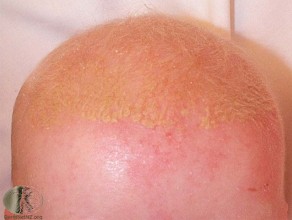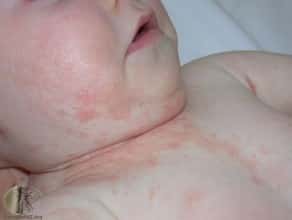Did you read the previous part about nevus simplex?
Seborrheic dermatitis, also known as cradle cap, is widespread in infants. It looks like a yellowish crust on a pink background on their head. Seborrheic dermatitis can spread and affect the face, torso and even the diaper area.
Explanations:
- Infant seborrheic dermatitis can appear and disappear on its own. It usually starts a week after childbirth and can continue for the first three months, or even longer. Many factors can cause dermatitis, which includes overproduction of sebum (fat) by the sebaceous glands, and infection of sebaceous zones by Malassezia, a common benign skin fungus.
- After childbirth and during the neonatal period, the skin’s sebaceous glands are more abundant and produce more sebum. This increased sebum (fat) leads to a disruption in the cutaneous flora, which leads to local inflammation with red spots, and an increase in the presence of Malassezia. This skin changes lead to the classic discovery of pinkish spots with yellowish squamates (crust) on the scalp. It can also be found behind the ears, on the face, neck and other folds, and even all around the body.
- Seborrheic dermatitis is a temporary condition which isn’t dangerous. When the situation is more severe, there may be itching as well.
Recommendations:
- Daily five-minute bath for the baby using warm water with mild soap and shampoo. Rinse and dry adequately.
- Apply a fragrance-free hydrating cream after the bath.
- Avoid covering the baby too much. This is to ensure that they aren’t too hot, sweat and as a consequence, their scalp becomes hot and damp.
- If the issue persists, an antifungal cream, such as ketoconazole 2% can be used, often combined with a reliable cortisone cream such as hydrocortisone 1%. Ketoconazole can also be used as a shampoo (Nizoral) if the baby has lots of hair, but be careful of their eyes.
- Avoid being over aggressive when removing the crust as it can cause pain for the baby.
- To remove the crust, apply mineral oil (sometimes with 6% salicylic acid) 15 minutes before shampooing. Salicylic acid helps soften the surface crust. After shampooing, you can use a fine tooth comb to remove the crust delicately. Don’t rub the crust and the spots can become sensitive.
- If the baby has spots of crust (erythroderma) around their body, you should consult a specialist.
For more information, please read Heat and Cradle Cap.


Photo source: dermnetnz.org
Continue reading with Fungal Infections.
Sources des photos : dermnetnz.org


